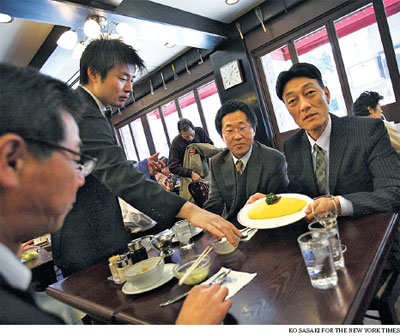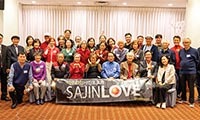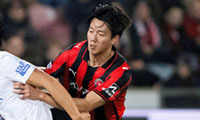[한글 번역] Japanese Twist on Burgers and Spaghetti

Taimeiken, a Tokyo restaurant, is famous for its yoshoku cuisine, based on Western food. Popular dishes include an omelet with ketchup.
By NORIMITSU ONISHITOKYO - Even outside Japan, fans of the country’s cuisine can order uni and o-toro with confidence, or urbanely express a preference for soba over udon. But what about “Napolitan,” cooked spaghetti that is rinsed in cold water, then stir-fried with vegetables in ketchup- Or “menchi katsu,” hamburger covered in bread crumbs and deep-fried- Or “omu rice,” an omelet lying over a mound of ketchup-flavored rice?
All are standards of a style of Japanese cuisine known as yoshoku, or “Western food,” in which European or American dishes were imported and reshaped to fit local tastes.
Today yoshoku is thoroughly Japanese. It is regularly featured on television cooking shows and mainstream magazines. The lines outside venerable upscale yoshoku restaurants here in Tokyo are as long as ever, mostly with older Japanese for whom yoshoku provided a first taste of a Western world they had not seen.
And yet it is virtually unknown to foreigners. The first Michelin guide to Tokyo, published in the fall of 2007, listed 150 restaurants; not one was a yoshoku establishment. Indeed, visitors to Japan seldom enter the places where yoshoku is served: homes, chain diners, family-owned neighborhood restaurants or upscale yoshoku establishments of long standing.
Yoshoku was born during Japan’s Meiji Restoration, the period that followed this isolationist country’s forced opening by America’s so-called Black Ships in 1854. Japanese were dispatched to Europe and America to learn about Western laws, weapons and industry. They also brought back the cuisine.
Shocked to discover how much shorter they were than Westerners, Japanese determined that they would catch up not only economically and militarily but also physically, by eating their food.
All yoshoku dishes have their roots in Western counterparts, but a key ingredient or a step in the cooking has been altered, or violated outright, with surprisingly delicious results. Instead of being served as soon as it is cooked, Napolitan spaghetti is allowed to sit, then reheated and stir-fried with vegetables.
Yoshoku’s popularity reached its peak in the decades following World War II. For mothers, it was easier to prepare than traditional Japanese food.
In the decades before most Japanese could afford to fly overseas, upscale yoshoku restaurants grew into symbols of the longed-for, glamorous Western world. Until the economic boom of the 1970s and 1980s, yoshoku was the only version of Western food known to many Japanese.
The yoshoku menu has changed little over the decades, said Hiroshi Modegi, 40, whose grandfather founded Taimeiken, a famous yoshoku restaurant in Tokyo’s Nihonbashi district, in 1931.
“Our customers want the old favorites,” said Mr. Modegi.
일본식 햄버거와 스파게티
도쿄에서 노리미쯔 오니시 기자
일본 바깥에서도 일식 애호가들은 우니와 오토로를 자신있게 주문하거나 우동보다 소바를 더 좋아한다고 점잖게 말할 수 있다. 그러면 스파게티 국수를 삶아서 찬물로 헹구어 낸 다음에 야채와 함께 케첩으로 볶은 ‘나폴리탄’은 어떤가? 빵 가루를 씌워 기름에 튀겨낸 햄버거인 ‘멘치 카츠’는? 케첩 맛 밥더미 위에 오믈렛을 얹어 놓은 ‘오므라이스’는?
모두 유럽과 미국 요리들이 수입되어 일본 사람들의 입맛에 맞도록 변형된 요쇼쿠, 또는 ‘서구 음식’이라 알려진 표준 일본식 요리들이다.
오늘날 요쇼쿠는 완전히 일본 것이다. 텔리비전 요리 프로그램과 주요 잡지에서 정규적으로 다루어진다. 도쿄의 유서깊은 고급 요쇼쿠 식당 밖에 늘어선 줄은 언제나 긴데 그 대부분은 요쇼쿠에서 자신들이 눈으로 보지 못한 서구 세계의 맛을 처음으로 본 나이 든 일본 사람들이다.
그런데 외국 사람들에겐 거의 알려져 있지 않다. 2007년 가을에 나온 도쿄 최초의 미슐랭 가이드에는 150개의 식당이 실려 있는데 그중 요쇼쿠 식당은 하나도 없다. 사실 일본을 방문한 사람들은 여간해선 요쇼쿠게 대접되는 곳들인 가정집, 체인 식당, 가족 소유 동네 식당이나 오래된 고급 요쇼쿠 식당에 발을 들여 놓지 않는다.
요쇼쿠는 쇄국하던 일본이 미국의 소위 흑선 때문에 하는 수 없이 나라의 문을 연 1854년 이후 시기인 메이지 유신 때 생겨났다. 유럽과 일본으로 서양의 법제도와 무기, 산업에 대해 배워 올 일본인들이 파견됐고 그들은 요리도 가지고 돌아왔다.
자신들이 서구인들에 비해 얼마나 작은지를 알고 충격을 받은 일본 사람들은 경제적, 군사적으로 뿐만 아니라 그들의 음식을 먹음으로써 신체적으로도 그들을 따라 잡겠다고 결심했다.
요쇼쿠 요리는 모두 상응하는 서구 음식에 뿌리를 두고 있지만 핵심 재료나 조리 과정 하나를 바꾸거나 아니면 철저히 위반해서 놀랍게도 맛있는 결과를 가져왔다. 조리하자마자 먹게 하는 대신에 나폴리탄 스파게티는 그냥 놓아 뒀다가 다시 데워 야채와 같이 볶는다.
요쇼쿠의 인기는 세계 제 2차 대전 이후 몇십년간 절정에 달했다. 어머니들에게도 전통적인 일본 음식보다 만들기가 더 쉬웠다.
대부분의 일본 사람들이 비행기를 타고 외국을 방문할 수 있게 되기 전 몇십년간, 고급 요쇼쿠 식당들은 선망의 대상인 멋진 서구세계의 상징으로 성장했다. 1970년대와 1980년대의 경제 호황 때까지 많은 일본 사람들이 아는 단 하나의 서구 음식이 요쇼쿠였다.
요쇼쿠 메뉴는 시간이 가도 별로 변한 것이 없다고 말하는 히로시 모데기(40)는 할아버지가 1931년에 도쿄의 니혼바시 구에 유명한 요쇼쿠 식당 타이메이켄을 창립했다.
“우리 손님들은 오랜 인기 메뉴를 원하십니다”고 모데기는 말했다.
어휘 해설
cuisine 요리, 조리법
stir-fried 기름에 볶다
deep-fried 기름에 튀기다
bread crumbs 빵가루, 빵 부스러기
standards 표준, 기준, 규격
Michelin guide 미슐랭사가 매년 발행하는 특정 지역 호텔, 식당등에 대한 가장 오래되고 권위있는 안내 및 평가 책자.
long standing 다년간의, 여러 해 동안에 걸친;오래 계속되는
seldom 좀처럼 ~ 않는, 드물게
Black Ships 15세기부터 19세기까지 일본에 도달한 서구 배들을 칭하나 특히 1853년 7월, 매튜 페리 제독이 인솔한 미국배들을 말한다.
스마터리빙
more [ 건강]
[ 건강]이제 혈관 건강도 챙기자!
[현대해운]우리 눈에 보이지 않기 때문에 혈관 건강을 챙기는 것은 결코 쉽지 않은데요. 여러분은 혈관 건강을 유지하기 위해 어떤 노력을 하시나요?
 [ 건강]
[ 건강]내 몸이 건강해지는 과일궁합
 [ 라이프]
[ 라이프]벌레야 물럿거라! 천연 해충제 만들기
 [ 건강]
[ 건강]혈압 낮추는데 좋은 식품
[현대해운]혈관 건강은 주로 노화가 진행되면서 지켜야 할 문제라고 인식되어 왔습니다. 최근 생활 패턴과 식생활의 변화로 혈관의 노화 진행이 빨라지고
사람·사람들
more
“취미생활로 다진 친목… 선후배들과 만든 모교사랑”
사진러브한인 사진 동호회 사진러브(회장 크리스 고)는 13일 용수산에서 송년모임을 갖고 한 해를 마무리하는 뜻깊은 시간을 가졌다. 이날 모임에…

[홀인원] 이상원 박사
일반외과 전문의 이상원(왼쪽) 박사가 지난 9일 뉴포트비치 소재 골프장 9번 홀(152야드)에서 레스큐 클럽으로 친 샷이 그대로 홀에 빨려 들…
[송년행사 게시판] 재미시인협회
재미시인협회(회장 지성심)는 오는 20일 오후 4시 가든스윗호텔에서 한 해를 마무리하며 동인지 ‘외지’ 제35집 출판 기념회와 ‘제23회 재미…
[송년행사 게시판] 향군단체 연합
6.25 참전유공자회와 대한민국 육군협회 등 남가주 지역 향군 단체 연합은 19일 오전 11시30분, 용궁에서 송년 행사를 개최한다. 드레스코…
[송년행사 화보] “이웃과 함께 나누고 지인과 함…
KYCC13일 윌튼 플레이스 초등학교에서 열린 ‘한인타운청소년회관(KYCC) 홀리데이 카니발’이 성황리에 막을 내렸다. 올해는 KYCC 창립 …
많이 본 기사
- 한국계 NASA 우주비행사 조니 김 “우주서 김치·밥 그리웠다”
- 엡스타인 파일 공개 다음날 트럼프 사진 삭제…야당서 탄핵 경고
- 김주하, 이혼사 최초 고백 “ ‘불륜’ 전 남편에 맞아 고막 파열..목 졸린 적도”
- 맘다니 승리 이끈 ‘감당 가능 생활비’, 내년 선거 화두 급부상
- 백악관 “인플레, 목표치보다 낮아…금리 인하 여지 충분”
- ‘매관매직’ 尹부부 금주 동반 재판행…특검, 최종 법리 검토
- 30년 만에 의문의 비극…과 동기에 피살 ‘승승장구’ MIT 교수
- BTS 정국과 열애설 후 첫 SNS..에스파 윈터, 커플 타투는 가렸다
- ‘최초+최초+최고’ 안세영, ‘허벅지 내리치는 투혼’→왕중왕전도 석권... ‘11회 우승’ 역대 최초 상금 100만 달러 돌파
- “노는 것도 지겨워” 박미선, 유방암 투병 중 ‘SNS 공구’ 갑론을박
- 판례 잘못 인용해 머스크 손들어준 판사… “AI 쓰다 오류” 의혹
- ‘韓 EPL 센터백 탄생하나’ 국가대표 이한범, 에버턴 관심 현지 보도
- 백악관 “인플레, 목표치보다 낮아…금리 더 일찍 내렸어야”
- 엡스타인 파일 공개 다음날 트럼프 사진 삭제…야당서 탄핵 경고
- 마두로 정권 더 옥죄는 美…베네수 연안서 유조선 추가 나포
- ‘손예진♥’ 현빈, 학부모 모드ON.. “아들이 배우 한다면? 하..” 한숨
- ‘反트럼프’ 공화 큰손, 작년 대선에만 약 5억4천800만달러 썼다
- 아마존, 키보드입력 데이터 분석해 위장취업 北노동자 적발
- 머스크 재산… 사상 초유 7천억달러 돌파
- ‘열애설→결별설 겪은’ 제니·지드래곤, 단둘이 ‘MMA’ 대상 쓸어갔다
- 신민아♥김우빈, 결혼식날 전한 깜짝 … 1
- 엡스타인파일 공개 후폭풍…법무부 ‘트… 2
- ‘SNS검증’ 美비자심사 지연에…빅테크, 또 직원 출국자제 권고
- 청와대 내년부터 본격화…여민관 ‘정책허브’로
- ‘공천개입’ 이준석 첫 특검 출석… “尹과 공범엮기 무리한 시도”
- 美, 우크라戰 종전 중재 속도…마이애미서 우크라·러 연쇄회동
- 교황, 전세계 추기경 바티칸 소집…내달 7∼8일 첫 회의
- 尹 김건희특검 첫 조사 8시간 반 만에 종료…6개 혐의 모두 부인
- 트럼프, ‘바이든 임명’ 직업 외교관 출신 대사들 대거 소환
- ‘미소천사’ 김아랑, 너무도 진솔했던 ‘은퇴 이유’ 고백 “경기 후 아쉬움 아닌 고마움 들어 결심했다”
- [건강포커스] “밤에 더 자주 깨는 어르신, 다음 날 인지수행 능력 떨어져”
- 위성락 “내년부터 농축·재처리·핵잠 한미협의 동시다발 진행”
- ‘새댁’ 함은정, 결혼식 하자마자..내조의 여왕
- ‘이젠 SD 송성문’ 3루엔 ‘3억 5000만 달러’ 마차도 버티는데... 단장이 답했다 “다양한 역할 소화할 것”
- “산타 지금 어디쯤?”…한국서도 70년 전통 전화 안내 즐긴다
- ‘중독유발 비판’ 챗GPT, 아동보호 기능 이어 ‘친절함 정도’ 도입
- ‘부상 아웃 공식 확정’ 이강인, 절뚝일 때부터 이상했다 “왼쪽 허벅지 근육 이상”... 폼 최고였는데 아쉬워
- 美·이집트 등 4개국, 가자 평화구상 진전·후속조치 논의
- 요르단 “美 시리아 IS 공습에 참여…안보 위협 저지”
- 안세영, ‘천적’ 야마구치도 넘었다…역대 최다승까지 단 한 걸음
- 젤렌스키 “우크라 선거 방식, 푸틴이… 3
- 與 “내란 2차 종합 특검해야”…국힘 “통일교 특검이 국민 명령”
- “네타냐후, 트럼프 만나 ‘이란 추가 타격’ 설명 계획”
- 쿠팡 주주, 美법원에 집단소송… “정… 1
1/5지식톡

-
 ☝️해외에서도 가능한 한국어 선생님…
0
☝️해외에서도 가능한 한국어 선생님…
0이 영상 하나면 충분합니다!♥️상담신청문의♥️☝️ 문의 폭주로 '선착순 상담'만 진행합니다.☎️ : 02-6213-9094✨카카오톡ID : @GOODEDU77 (@골뱅이 꼭 붙여주셔야합니다…
-
 테슬라 자동차 시트커버 장착
0
테슬라 자동차 시트커버 장착
0테슬라 시트커버, 사놓고 아직 못 씌우셨죠?장착이 생각보다 쉽지 않습니다.20년 경력 전문가에게 맡기세요 — 깔끔하고 딱 맞게 장착해드립니다!장착비용:앞좌석: $40뒷좌석: $60앞·뒷좌석 …
-
 식당용 부탄가스
0
식당용 부탄가스
0식당용 부탄가스 홀세일 합니다 로스앤젤레스 다운타운 픽업 가능 안녕 하세요?강아지 & 고양이 모든 애완동물 / 반려동물 식품 & 모든 애완동물/반려동물 관련 제품들 전문적으로 홀세일/취급하는 회사 입니다 100% …
-
 ACSL 국제 컴퓨터 과학 대회, …
0
ACSL 국제 컴퓨터 과학 대회, …
0웹사이트 : www.eduspot.co.kr 카카오톡 상담하기 : https://pf.kakao.com/_BEQWxb블로그 : https://blog.naver.com/eduspotmain안녕하세요, 에듀스팟입니다…
-
 바디프렌드 안마의자 창고 리퍼브 세…
0
바디프렌드 안마의자 창고 리퍼브 세…
0거의 새제품급 리퍼브 안마의자 대방출 한다고 합니다!8월 23일(토)…24일(일) 단 이틀!특가 판매가Famille: $500 ~ $1,000Falcon: $1,500 ~ $2,500픽업 & 배송직접 픽업 가능LA…
케이타운 1번가
오늘의 1면
오피니언
 한영일 / 서울경제 논설위원
한영일 / 서울경제 논설위원[만화경] 웰다잉 인센티브
 캐슬린 파커 워싱턴포스트 칼럼니스트
캐슬린 파커 워싱턴포스트 칼럼니스트 [캐슬린 파커 칼럼] 아이들을 온라인에서 보호하기
 양상훈 수필가ㆍ시인
양상훈 수필가ㆍ시인 [한국춘추] 경제대공황ㆍ제2차 세계대전 승리로 극복한 루스벨트 리더쉽

[왈가 왈부] 고환율에 외환 건전성 완화·서학개미 규제… 미봉책 아닌가요
 수잔 최 한미가정상담소 이사장 가정법 전문 변호사
수잔 최 한미가정상담소 이사장 가정법 전문 변호사 [수잔 최 변호사의 LIFE &] AI 시대 편리함에 안주하지 말자
 김도년 성균관대 건축학과 교수 스마트도시·건축학회장
김도년 성균관대 건축학과 교수 스마트도시·건축학회장 [로터리] 지멘스가 만드는 미래 동네
1/3지사별 뉴스

퀸즈장로교회 ‘사랑의 바구니’130개 이웃에 전달
퀸즈장로교회가 18일 크리스마스를 앞두고 교인들의 정성과 사랑이 듬뿍 담긴 ‘사랑의 바구니’ 130개를 소방서와 경찰서, 요양원, 선교회, 그…
시민권 박탈 착수⋯매달 200명

“이웃 돌보는 여러분이 동역자”
워싱턴성광교회(담임목사 임용우)는 18일 한인단체와 소방서‧도서관 등에 총 2만9천 달러의 성금을 전달했다. 지난 2011년부터 15년째 지역…
소기업 지원에 1천만 달러 투자

백악관 “인플레, 목표치보다 낮아…금리 더 일찍 내렸어야”
케빈 해싯 백악관 국가경제위원회(NEC) 위원장은 21일 중앙은행인 연방준비제도(Fed·연준)가 “금리를 더 일찍 내렸어야 했다”고 말했다.해…
엡스타인 파일 공개 다음날 트럼프 사진 삭제…야당서 탄핵 경고

오늘 하루 이 창 열지 않음 닫기 




















































.png)


댓글 안에 당신의 성숙함도 담아 주세요.
'오늘의 한마디'는 기사에 대하여 자신의 생각을 말하고 남의 생각을 들으며 서로 다양한 의견을 나누는 공간입니다. 그러나 간혹 불건전한 내용을 올리시는 분들이 계셔서 건전한 인터넷문화 정착을 위해 아래와 같은 운영원칙을 적용합니다.
자체 모니터링을 통해 아래에 해당하는 내용이 포함된 댓글이 발견되면 예고없이 삭제 조치를 하겠습니다.
불건전한 댓글을 올리거나, 이름에 비속어 및 상대방의 불쾌감을 주는 단어를 사용, 유명인 또는 특정 일반인을 사칭하는 경우 이용에 대한 차단 제재를 받을 수 있습니다. 차단될 경우, 일주일간 댓글을 달수 없게 됩니다.
명예훼손, 개인정보 유출, 욕설 등 법률에 위반되는 댓글은 관계 법령에 의거 민형사상 처벌을 받을 수 있으니 이용에 주의를 부탁드립니다.
Close
x